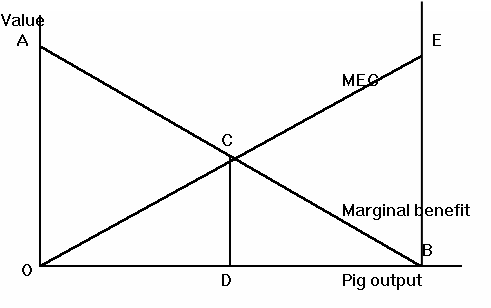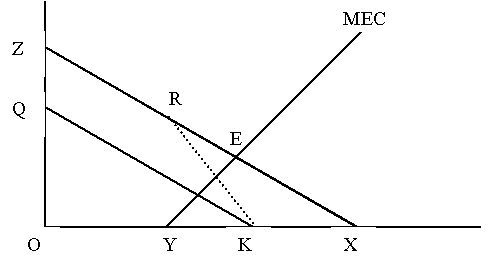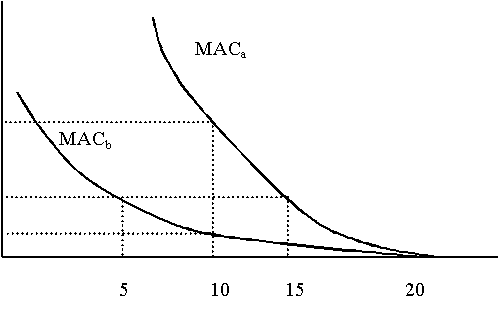
While agricultural policy reform will alleviate some of the environmental stress due to intensive agricultural production, further direct government intervention may be justified to limit negative externalities or to stimulate the supply of public goods. In this lecture, we consider:
Some adverse environmental impacts may be internalised into a farmer's decision-making process, e.g. soil erosion, as this may impact on the revenue-generating potential of the farm in the future. However, the problem with many environmental impacts is that the costs are not borne by the producer because there is no mechanism to price the damage being done and require the producer to pay. These environmental costs are externalised, and there is thus divergence between the marginal private cost of production (to which the producer responds) and the marginal social cost of production (which determines the socially optimal level of production). Over-production of farm output which causes environmental damage is shown in the following diagram. The farmer would produce at Q1 where his marginal private cost equals marginal revenue, although the socially efficient level of output is Qo which takes into account the additional social costs of agricultural production.

The policy question is what is the least-cost mechanism of bringing production down to the socially optimal level (efficiency), and what are the income distribution consequences of alternative courses of action (equity)?
In the case of negative environmental impacts, there is now general endorsement of the Polluter
Pays Principle (PPP) which has been adopted by all OECD countries. However, the question of what is 'pollution'
whose avoidance costs should be borne by producers and how to define 'environnmental benefits' for which producers
should be compensated is a social construct which depends entirely on the distribution
of property rights in the environment in any society.
For example, take the issue of discharging slurry into a stream. If the law takes the view that a farmer has the
right to use the stream in this way, then the public must bear the cost of compensating the farmer for requiring
him to adopt an alternative, and presumably more costly, way of disposing of his slurry. If, on the other hand,
the view is taken that the public's right to enjoy the stream in its original state is the prior one, then the
farmer would be prohibited from discharging slurry, or might be permitted to do so (up to a level compatible with
the capacity of the stream) for an appropriate fee.
Other examples (note how the problem changes depending on the initial distribution of property rights. Reflect
on your own view as to the reasonableness of the assignment of property rights in each instance):
In each instance, there will be a reference benchmark which will separate what farmers are allowed to do in terms of managing their land without penalty, or expected to provide by way of positive environmental benefits without compensation, and situations where penalities or compensation apply. The position of this reference benchmark is likely to change over time, and to vary across societies, depending on their environmental preferences and the distribution of political power. In what follows we assume that there is an agreed reference benchmark and that what constitutes pollution or a negative externality is well defined.
The reason why environmental bads are overproduced and environmental benefits are underproduced is because of the absence of private property rights in the environment, thus giving rise to market failure and the existence of negative or positive externalities. While market failure is usually taken as justifying some form of government intervention, one tradition in the literature suggests that the environmental problem could be resolved if the government simply ensured that property rights in the environment existed. This insight was made by Ronald Coase and is often referred to as the Coase Theorem. It can be illustrated as follows.

Consider a water treatment plant and a pig farmer. The pig farmer has the possibility of
disposing of the slurry from his pigs into the river. If he does this, however, the costs to the water treatment
plant of cleaning the water increase. The diagram shows the marginal benefit AB to the pig farmer and the marginal
damage OE suffered by the treatment plant, both as a function of Q, the number of pigs produced.
Without considering the external effect for the treatment plant, the pig farmer will produce OB pigs. This number
maximises his profit which is equal to OAB. The area OBE gives the amount of damage suffered by the treatment plant.
The difference between these two quantities represents the net gain to social welfare from the pig farmer's activity.
As drawn, this is close to zero.
Social welfare could be maximised if the pig farmer reduced his output of pigs to OD. At this level of output,
the marginal benefit of an additional pig just equals the marginal cost of additional pollution. Increase in social
welfare is shown by OAC.
Coase's insight was that, given well-defined property rights, negotiation between the parties is a simple means
to bring about social efficiency without government intervention. To see this, consider two opposite rules. One
is the zero liability rule, where there is no law against pollution. The other is the full liability rule, which
requires that externalities be limited to zero.
Under the zero liability rule, the pig farmer can continue to dispose of his slurry into the river without taking
into account its effect on the water treatment plant.
However, it is in the interests of the plant to offer the farmer compensation to reduce the number of pigs and
thus the level of pollution. At any point to the right of D, the costs to the plant are greater than the marginal
benefit to the farmer. Hence, the plant should be able to 'bribe' the farmer to reduce output to the socially efficient
level D.
Under the full liability rule, the treatment plant enjoys a right to clean water. In order to operate, the pig
farmer will have to pay the treatment plant to accept a particular level of pollution. Again, because the marginal
benefits to the farmer at any point to the left of D are greater than the marginal costs to the plant, it should
be possible for the farmer to 'bribe' the plant to allow him to increase output to the socially optimal level.
Under either rule, the resulting output is Pareto-optimal and thus independent of the initial distribution of property
rights. Of course, the distribution of income between the plant and the farmer is crucially influenced by the nature
of the property right assignment rule adopted.
Critics point to the impracticality of this solution to environmental problems in the real world:
However, property rights assignment may have a role to play in one class of environmental problems, namely, those caused by the 'tragedy of the commons'. This refers to the (mis)use of common property resources such as fish stocks in the ocean, forest resources or (of most relevance to Irish agriculture) overgrazing on common land. The basic idea is that, although everyone recognises that environmental degradation is taking place, no one individual has an incentive to reduce production unless everyone does so, and there is no mechanism to ensure this. One solution to this problem would be to privatise the resource, on the asssumption that an individual owner would now have the incentive to conserve the resource for future exploitation. Commonages are quite common in mountain areas in Ireland but have been damaged in recent years by overgrazing caused by increased sheep numbers. Assistance can be provided to divide up commonages and to fence off individual areas, although whether this is a preferable solution to one where rules could be more effectively enforced by the group is an open question.
Market-based instruments (MBIs) create incentives that encourage people, acting in their own self-interest, simultaneously to treat the environment in a way that is in the best interests of society. MBIs have two potential advantages over other types of instruments:
MBIs work through different mechanisms:
There are two market-based solutions to controlling pollution:
A common approach to aligning the private and social costs of negative externalities is through a tax on the polluter based on an evaluation of the damage caused. In the diagram below, X is the level of output if the costs of pollution are ignored and K is the socially optimal production level. Two points should be noted about this diagram. First, the optimal level of pollution is not necessarily zero, as many environmentalists often argue. Second, the environment often has some assimilative capacity, so that up to a certain level of production there are no pollution costs incurred.

The government could impose a simple flat-rate tax QZ on output
which would remove the incentive to increase production beyond the socially-optimal
level K. Note that a flat-rate tax can be criticised as unjust because (a) it taxes output over levels OZ which
do not generate external costs, and (b) it has a uniform effect on all output YK, despite the fact that marginal
increases in output above Z add increasing marginal amounts of external costs. A tax system which would overcome
these objections is shown by the curve RK. Such a tax would be levied on pollution emissions above the level where they incur environmental costs.
Note the following points:
Alternatively, subsidies can be paid to farmers to encourage them to avoid pollution (although this runs counter to the polluter pays principle). Examples include:
This is a market-based scheme in the sense that it uses economic mechanisms to minimise
the total cost of meeting a particular pollution target. Suppose, for example, that the government wishes to limit
nitrogen application to a pre-determined level decided in the light of environmental criteria. Each farmer is given
a quota, or permit, to use a specified quantity of nitrogen but these quotas can be traded. Farmers who decide
to use less fertiliser than their quota, by managing their fertiliser use better or by altering their product mix,
would be able to sell their excess permits. Those farmers where the marginal value of fertiliser use was particularly
high would be willing to buy permits. Through permit trading, the desired reduction in nitrogen use can be achieved
in a way which equalises the marginal abatement cost across farmers and thus minimises the total social cost of
achieving the environmental target (this is explained further below).
Note the following:
Regulations (or non-market approaches) to control environmental pollution can be divided into two types:
Examples of regulatory approaches, including the EU Nitrates Directive, Water Pollution
Acts and Integrated Pollution Control licences, are discussed.
Regulatory approaches can lead to higher total costs of pollution abatement. Consider the situation of two polluters
with different marginal abatement cost curves shown in the diagram below. A marginal abatement cost curve shows
the cost to the farmer (usually in terms of lost output) from complying with a pollution standard. Assume that
each farm initially produces 20 units of pollution and that the government introduces a regulation limiting pollution
emissions to half this total. If each farm is required to reduce its pollution by this amount, the costs of reducing
the marginal unit of pollution are much higher on one farm than the other. The costs of a regulatory approach can
be minimised by allowing trade in emissions permits. In this example, the low cost abater would sell its rights
to pollute to the high cost abater until the marginal abatements costs were equalised across farms. This would
occur with the farm with low abatement costs reducing its pollution emissions to 5 units while the high-cost abatement
farm would only reduce its emissions to 15 units. However, this is the least cost solution since most of the required
reduction in pollution takes place on the farm where it is cheapest to make this reduction.

The Nitrates Directive aims at reducing water pollution caused or induced by nitrates from
agricultural sources and at preventing further such pollution. It targets water affected by pollution or which
could be affected if action is not taken. Member States must designate as vulnerable zones all known areas of land
for which the corresponding
· surface freshwater contains or could contain more than 50 mg nitrates per litre;
· groundwater contains more than 50 mg/l nitrate;
· natural freshwater lakes, other freshwater bodies, estuaries, coastal waters and marine waters are found
to be eutrophic or in the near future may become eutrophic.
To achieve the objectives, Member States have to adopt measures both at general level and for vulnerable zones.
They have to establish codes of good agricultural practice to be implemented by farmers on a voluntary basis and,
where necessary, a programme promoting the application of the codes. As regards in particular the vulnerable zones,
Member States have to establish binding action programmes. They have to be implemented within four years of their
establishment and shall ensure that the amount of manure spread within the zone does not exceed 170 kg N/ha.
Agriculture and forestry play dual roles with respect to climate change. They contribute to it through emissions but can potentially also contribute to mitigation strategies through sequestration and through development of renewable energy resources. In addition, of course, climate change itself will have reperecussions for Irish agriculture.
In Ireland, because of the importance of cattle production in agriculture, the sector contributes around 28% of Ireland's total GHG emissions. Agricultural GHG emissions have been falling since 1999. Emissions are predominantly non-CO2 gases and arise primarily from enteric fermentation in animals, management of animal manures and agricultural soils. The decision to adopt full decoupling of direct payments from production should lead to reduced animal numbers and a projected reduction in emissions.The possibility of reducing methane emissions from livestock through alterend diets is being examined.
Scott, S., 2005, Fertiliser Taxes - Implementation Issues, Final Report, Wexford, Environmental Protection Agency.
(discusses the merits of a fertiliser tax to improve water quality, in the context of a good discussion of economic instruments to control pollution)
Marc O. Ribaudo, Richard D. Horan, and Mark E. Smith, 1999. Economics of Water Quality Protection From Nonpoint Sources: Theory and Practice. Resource Economics Division, Economic Research Service, U.S. Department of Agriculture. Agricultural Economic Report No. 782.
(skip the US material and concentrate on the core chapters 3-5 which describe the policy instruments. There is also an Executive Summary for those who do not want to read the whole report).
Bonnieux, F. and Rainelli, P. 2002. Economics and the interface between agriculture and nature, in Brouwer, F. and Van der Straaten, J. eds, Nature and Agriculture in the European Union, Cheltenham, Edward Elgar ARTS 338.1094 P2.
Colman, D., 1993, Environmental economics and agricultural policy, in Rayner, A. and Colman, D. eds., Current Issues in Agricultural Economics, Macmillan.
Department of the Environment, Heritage and Local Government Nitrates Directive webpage
Regan, S. 2003, New environmental requirements - meeting the challenge, Paper to the Teagasc 2003 Annual REPS Conference, Tullamore.
(good discussion of the objectives and likely economic impact of the Nitrates Directive, written prior to the Action Plan being promulgated).
Departments of Agriculture and Environment and Local Government, 2004, National Action Programme under the Nitrates Directive, Dublin.
Heritage Council, 1999, The Implementation of the Nitrates Directive in Ireland, Appendix V of Impact of Agricultural Schemes and Payments on Aspects of Ireland's Heritage, Kilkenny.
(helps to explain some of the background to the delay in transposing the directive into Irish legislation)
Commission, 2007, Report on implementation of Council Directive 91/676/EEC concerning the protection of
waters against pollution caused by nitrates from agricultural sources for the period
2000-2003, COM(2007) 120, Brussels.
For up to date references to the political controversy in Ireland, Google using search terms such as 'ireland, nitrates directive, farmers' etc.
Controlling greenhouse gas emissions from agriculture
Smith, P. et al., 2008. Cool Farming: Climate Impacts of Agriculture and Mitigation Potential, Greenpeace.
(describes how agriculture contributes to GHG emissions and solutions to help reduce its contribution to climate change)
Behan, J. and McQuinn, K., 2003, Projecting net greenhouse gas emissions from Irish agriculture and forestry, ESRI Quarterly Economic Review, Spring 2003.
Department of the Environment, Heritage and Local Government, 2007, National Climate Change Strategy 2017-2013, Dublin.
(has short 2 page section on Agriculture, Land Use and Forestry)
Department of the Environment, Heritage and Local Government Climate change webpage
UCD School of Agriculture, 2007, Estimation of Emissions of
Greenhouse Gases from Agriculture and Strategies
for their Reduction - Synthesis Report, Wexford, Environmental Protection Agency, 11pp.
Scott, S. 1997. 'Agriculture and forestry', Chapter 4 in Barrett, A., Lawlor, J. and Scott, S. The Fiscal System and the Polluter Pays Principle, Aldershot, Ashgate.